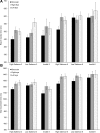Binocular advantage for prehension movements performed in visually enriched environments requiring visual search
- PMID: 25506323
- PMCID: PMC4246685
- DOI: 10.3389/fnhum.2014.00959
Binocular advantage for prehension movements performed in visually enriched environments requiring visual search
Abstract
The purpose of this study was to examine the role of binocular vision during a prehension task performed in a visually enriched environment where the target object was surrounded by distractors/obstacles. Fifteen adults reached and grasped for a cylindrical peg while eye movements and upper limb kinematics were recorded. The complexity of the visual environment was manipulated by varying the number of distractors and by varying the saliency of the target. Gaze behavior (i.e., the latency of the primary gaze shift and frequency of gaze shifts prior to reach initiation) was comparable between viewing conditions. In contrast, a binocular advantage was evident in performance accuracy. Specifically, participants picked up the wrong object twice as often during monocular viewing when the complexity of the environment increased. Reach performance was more efficient during binocular viewing, which was demonstrated by shorter reach reaction time and overall movement time. Reaching movements during the approach phase had higher peak velocity during binocular viewing. During monocular viewing reach trajectories exhibited a direction bias during the acceleration phase, which was leftward during left eye viewing and rightward during right eye viewing. This bias can be explained by the presence of esophoria in the covered eye. The grasping interval was also extended by ~20% during monocular viewing; however, the duration of the return phase after the target was picked up was comparable across viewing conditions. In conclusion, binocular vision provides important input for planning and execution of prehension movements in visually enriched environments. Binocular advantage was evident, regardless of set size or target saliency, indicating that adults plan their movements more cautiously during monocular viewing, even in relatively simple environments with a highly salient target. Nevertheless, in visually-normal adults monocular input provides sufficient information to engage in online control to correct the initial errors in movement planning.
Keywords: binocular vision; eye-hand coordination; phoria; reaching and grasping movements; visual search.
Figures






Similar articles
-
The effects of monocular viewing on hand-eye coordination during sequential grasping and placing movements.Vision Res. 2016 Nov;128:30-38. doi: 10.1016/j.visres.2016.08.006. Epub 2016 Sep 26. Vision Res. 2016. PMID: 27664351
-
When two eyes are better than one in prehension: monocular viewing and end-point variance.Exp Brain Res. 2004 Oct;158(3):317-27. doi: 10.1007/s00221-004-1905-2. Epub 2004 May 26. Exp Brain Res. 2004. PMID: 15164152
-
Effects of strabismic amblyopia and strabismus without amblyopia on visuomotor behavior: III. Temporal eye-hand coordination during reaching.Invest Ophthalmol Vis Sci. 2014 Nov 11;55(12):7831-8. doi: 10.1167/iovs.14-15507. Invest Ophthalmol Vis Sci. 2014. PMID: 25389201
-
The role of binocular vision in the control and development of visually guided upper limb movements.Philos Trans R Soc Lond B Biol Sci. 2023 Jan 30;378(1869):20210461. doi: 10.1098/rstb.2021.0461. Epub 2022 Dec 13. Philos Trans R Soc Lond B Biol Sci. 2023. PMID: 36511416 Free PMC article. Review.
-
Dynamic assessment of binocular eye movement coordination: norms and functional implications.Med Hypothesis Discov Innov Ophthalmol. 2014 Spring;3(1):31-7. Med Hypothesis Discov Innov Ophthalmol. 2014. PMID: 24804278 Free PMC article. Review.
Cited by
-
Some binocular advantages for planning reach, but not grasp, components of prehension.Exp Brain Res. 2019 May;237(5):1239-1255. doi: 10.1007/s00221-019-05503-4. Epub 2019 Mar 8. Exp Brain Res. 2019. PMID: 30850853 Free PMC article.
-
Stereopsis: are we assessing it in enough depth?Clin Exp Optom. 2018 Jul;101(4):485-494. doi: 10.1111/cxo.12655. Epub 2018 Jan 27. Clin Exp Optom. 2018. PMID: 29377291 Free PMC article. Review.
-
The effect of three-dimensional visualisation on performance in endoscopic sinus surgery: A clinical training study using surgical navigation for movement analysis in a randomised crossover design.Clin Otolaryngol. 2020 Mar;45(2):211-220. doi: 10.1111/coa.13494. Epub 2020 Jan 27. Clin Otolaryngol. 2020. PMID: 31846558 Free PMC article. Clinical Trial.
-
Gaze-grasp coordination in obstacle avoidance: differences between binocular and monocular viewing.Exp Brain Res. 2015 Dec;233(12):3489-505. doi: 10.1007/s00221-015-4421-7. Epub 2015 Aug 23. Exp Brain Res. 2015. PMID: 26298046
-
Binocular Viewing Facilitates Size Constancy for Grasping and Manual Estimation.Vision (Basel). 2022 Apr 20;6(2):23. doi: 10.3390/vision6020023. Vision (Basel). 2022. PMID: 35645377 Free PMC article.
References
LinkOut - more resources
Full Text Sources
Other Literature Sources

